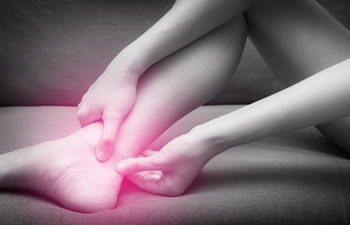 The Achilles tendon is the band of tissue that connects the back of the calf muscle to the heel bone. Achilles tendinopathy occurs when the Achilles tendon is stressed and experiences very small tears or other damage. “Tendinitis” refers to fresh damage, usually within 10 days, and once the inflammation has gone away and only the tears remain, “tendinopathy” occurs. Those suffering from Achilles tendinopathy typically have severe pain and weakening around the ankle. Symptoms usually worsen during physical activity, but relief may be found with heat or ice packs. Those who are experiencing Achilles tendinopathy should consult with a podiatrist. Pain management is the first step, and orthotics, ankle braces or walking boots may also be necessary.
The Achilles tendon is the band of tissue that connects the back of the calf muscle to the heel bone. Achilles tendinopathy occurs when the Achilles tendon is stressed and experiences very small tears or other damage. “Tendinitis” refers to fresh damage, usually within 10 days, and once the inflammation has gone away and only the tears remain, “tendinopathy” occurs. Those suffering from Achilles tendinopathy typically have severe pain and weakening around the ankle. Symptoms usually worsen during physical activity, but relief may be found with heat or ice packs. Those who are experiencing Achilles tendinopathy should consult with a podiatrist. Pain management is the first step, and orthotics, ankle braces or walking boots may also be necessary.
Achilles tendon injuries need immediate attention to avoid future complications. If you have any concerns, contact one of our podiatrists of Summit Podiatry. Our doctors can provide the care you need to keep you pain-free and on your feet.
What Is the Achilles Tendon?
The Achilles tendon is a tendon that connects the lower leg muscles and calf to the heel of the foot. It is the strongest tendon in the human body and is essential for making movement possible. Because this tendon is such an integral part of the body, any injuries to it can create immense difficulties and should immediately be presented to a doctor.
What Are the Symptoms of an Achilles Tendon Injury?
There are various types of injuries that can affect the Achilles tendon. The two most common injuries are Achilles tendinitis and ruptures of the tendon.
Achilles Tendinitis Symptoms
- Inflammation
- Dull to severe pain
- Increased blood flow to the tendon
- Thickening of the tendon
Rupture Symptoms
- Extreme pain and swelling in the foot
- Total immobility
Treatment and Prevention
Achilles tendon injuries are diagnosed by a thorough physical evaluation, which can include an MRI. Treatment involves rest, physical therapy, and in some cases, surgery. However, various preventative measures can be taken to avoid these injuries, such as:
- Thorough stretching of the tendon before and after exercise
- Strengthening exercises like calf raises, squats, leg curls, leg extensions, leg raises, lunges, and leg presses
If you have any questions please feel free to contact one of our offices located in Wilmington, Whiteville, and Wallace, NC . We offer the newest diagnostic tools and technology to treat your foot and ankle needs.
